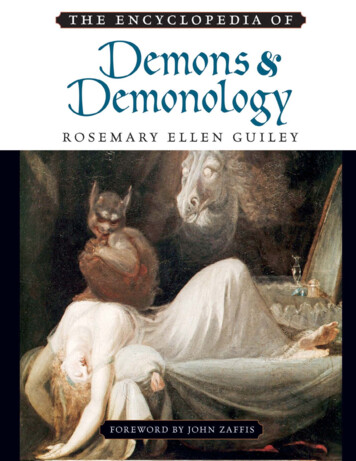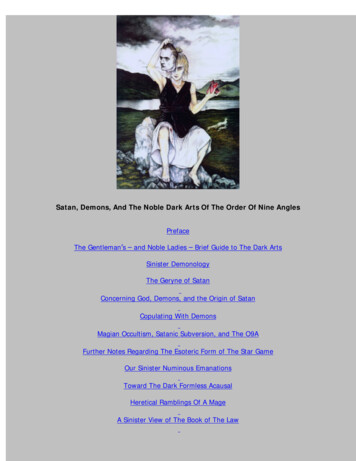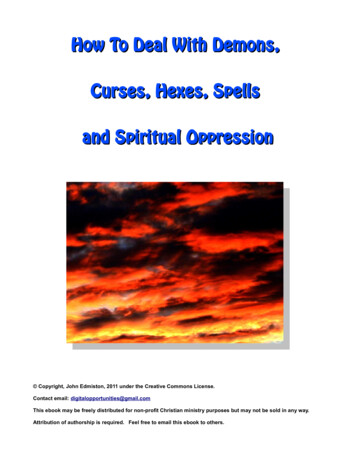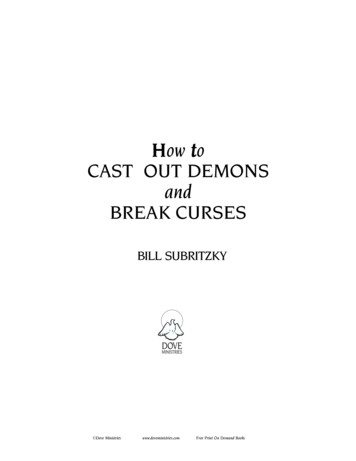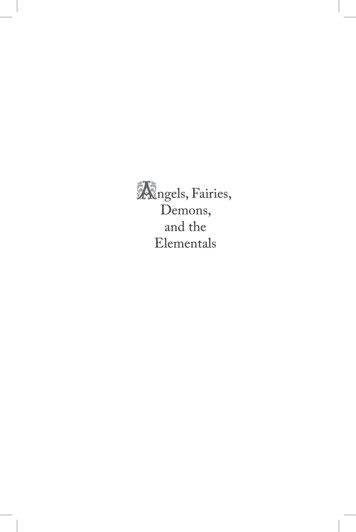
Transcription
ngels, Fairies,Demons,and theElementals
Credit: “Enchanted Tree”: Ellerslie/Dreamstime.com.
ngels, Fairies,Demons,and theElementalsWith an Edgar Cayce Perspectiveon the Supernatural WorldJohn Van AukenA.R.E. Press x Virginia Beach x Virginia
Copyright 2015by John Van Auken1st Printing, September 2015Printed in the U.S.A.All rights reserved. No part of this book may be reproduced or transmitted in any form or by any means, electronic or mechanical, includingphotocopying, recording, or by any information storage and retrievalsystem, without permission in writing from the publisher.A.R.E. Press215 67th StreetVirginia Beach, VA 23451-2061ISBN 13: 978-0-87604-770-5Edgar Cayce Readings 1971, 1993-2007by the Edgar Cayce Foundation.All Rights Reserved.Cover design by Christine Fulcher
ContentsAbout Edgar Cayce.vii1Don’t Look Beyond Yourself.12Angels and the Heavens.73Encounters with Angels. 414Fairies, Sprites, Elves, and More.575Reverend Kirk’s “The Secret Commonwealth”. 736Excerpts from J.R.R. Tolkien’s “On Fairy Stories”. 837Encounters with Little People. 1078Demons, Fallen Angels, and the Dark Forces.1239The Elementals.13910 Second Sight and the Sixth Sense.145
Illustrations“Enchanted Tree”: Ellerslie77/Dreamstime.com.ii“Mysterious Old Forest”: Subbotina/Dreamstime.com.xiiGustave Doré: The Emporium.6Gustave Doré: Elijah is nourished by an angel, I Kings 19. 40“Enchanted Elves House”: Ellerslie77/Dreamstime.com. 56“Fairy Rocks and Flowers”: Unholyvault/Dreamstime.com.72John Albert Bauer (1882-1918): Trolls and the Fairy, Wikimedia. 82Edward Robert Hughes (1851-1914): “Midsummer Eve,” a fairyring, Wikimedia.106William Blake (1757-1827): Lucifer before the Fall.122Depiction of Human Double-Helix DNA Strand from the NationalInstitute of Standards.138Anubis is an Egypt icon of the “sixth sense,” using the scent of thelotus to guide souls through the Underworld to the Heavens(Author’s collection).144
iAbout Edgar CayceEdgar Cayce (pronounced KAY-see, the same as the English nameCasey) was born on a farm near Hopkinsville, Kentucky, onMarch 18, 1877. As a child, he displayed unusual powers ofperception. At the age of six, he told his parents that he could see andtalk with “visions,” sometimes of relatives who had recently died, andon occasion he saw angels. He could also sleep with his head on hisschoolbooks and awaken with a photographic recall of their contents,even citing the page number upon which the answer appeared. However, after completing seventh grade, he left school—which was notunusual for boys of his age at that time.When he was twenty-one, he developed a paralysis of the throatmuscles that caused him to lose his voice. When doctors were unable tofind a physical cause for this condition, Edgar Cayce asked an acquaintance to help him re-enter the same kind of hypnotic sleep that hadenabled him to memorize his schoolbooks as a child. The friend gavehim the necessary suggestions, and once he was in this trance-like state,vii
Cayce spoke clearly and directly without any difficulty. He instructedthe “hypnotist” to give him a suggestion to increase the blood flow tohis throat; when the suggestion was given, Cayce’s throat turned bloodred. Then, while still under hypnosis, Cayce recommended some specificmedication and manipulative therapy that would aid in restoring hisvoice completely.On subsequent occasions, Cayce would go into the hypnotic state todiagnose bodily conditions and prescribe a course of action to restorehealth. Doctors around Hopkinsville and Bowling Green, Kentucky,took advantage of Cayce’s unique talent to diagnose their patients. Theysoon discovered that all Cayce needed was the name and address of apatient to “tune in” telepathically to that individual’s mind and body.The patients didn’t have to be near Cayce, he could tune-in to themwherever they were.When one of the young MDs working with Cayce submitted a reporton his strange abilities to a clinical research society in Boston, the reactions were ones of astonishment. On October 9, 1910, The New York Timescarried two pages of headlines and pictures. From then on, people fromall over the country sought the so-called “Sleeping Prophet,” a nicknamethat came from one of the many books written about him.The routine he used for conducting a trance-diagnosis was to reclineon a couch with his hands over his “third eye” region on his forehead.When he saw a white light, he moved his hands to his solar-plexus. Atthis time, his eyelids would begin fluttering, and his breathing wouldbecome deep and rhythmic. This was the signal to the conductor(usually his wife, Gertrude) to make verbal contact with Cayce’s subconscious by giving a suggestion. Unless this procedure was timed tosynchronize with his fluttering eyelids and the change in his breathing,Cayce would proceed beyond his trance state and simply fall fast asleep.However, once the suggestion was made, Cayce would access whateveror whoever was necessary to fulfill the suggestion. In his health cases,he would proceed to describe the patient as though he or she weresitting right next to him, and his mind was functioning much as anx-ray scanner, seeing into every organ of the inquirer’s body. When hewas finished, he would say, “Ready for questions.” However, in manycases, his mind would have already anticipated the patient’s questions,answering them during the main session. Eventually, he would say, “Weviii
are through for the present,” whereupon the conductor would give thesuggestion for him to return to normal consciousness and balance theenergies in his body.If this procedure were in any way violated, Cayce would be in serious personal danger. On one occasion, he remained in a trance state forthree days and had actually been given up for dead by the attendingdoctors.At each session, a stenographer (usually Gladys Davis, his personalsecretary) would record in shorthand everything Cayce said. Sometimes,during a trance session, Cayce would even correct the stenographer’sspelling. It was as though his mind were in touch with everythingaround him and beyond.Each client was identified with a number in an effort to keep theirnames private. For example, hypnotic material for Edgar Cayce is filedunder the number 294. His first “reading,” as they were called, would benumbered 294-1, and each subsequent reading would increase the dashnumber (294-2, 294-3, and so on). Whenever a reading is referencedin this book, it will be followed by the reading number. Since quotesfrom the readings are usually only a small part of the reading given(some readings can include several pages of material), different quotescan have the same reading number. Some numbers refer to groups ofpeople, such as the first “Study Group,” (series 262); and some numbersrefer to specific research or guidance readings, such as the 254 series,containing the “Work” readings dealing with the overall work of thenonprofit organization founded by Cayce (the Association for Researchand Enlightenment), and the 364 and 996 series containing the readings given on Atlantis. His psychic discourses were termed “readings,”because it was believed that he was “reading” sources. Among thesources read were the minds of the questioners, the Akashic Records(also known as “The Book of Life”), the so-called collective unconsciousness,and even God’s all-knowing mind, which he referred to as the UniversalConsciousness.It was August 10, 1923, before anyone thought to ask the “sleeping”Cayce for insights beyond physical health—questions about life, death,and human destiny and origins. In a small hotel room in Dayton,Ohio, Arthur Lammers asked the first set of philosophical questionsthat were to lead to an entirely new way of using Cayce’s strangeix
abilities. It was during this line of questioning that Cayce first beganto talk about reincarnation as though it were as real and natural asthe functioning of a physical body. This shocked and challenged Cayceand his family. They were deeply religious people, doing this work tohelp others, because that’s what their Christian faith taught. As a child,Cayce began to read the Bible from front to back, and did so every yearof his adult life. Reincarnation was not part of the Cayce family’s reality. Yet, the healings and help continued to come, so the Cayce familycontinued with the physical material, but cautiously reflected on thestrange philosophical material. Ultimately, the Cayce’s began to acceptthe ideas, though not as “reincarnation” per se. Edgar Cayce preferred tocall it, “The Continuity of Life.” He felt that the Bible did contain muchevidence that life, the true life in the Spirit, is continual. And if there islife after death—the life of the soul—well, then it’s just a short step forthe soul to also have life before birth. In fact, he found that deep in thelore of Christianity, the “preexistence of the soul” was an accepted truth,one that explained how free-willed souls incarnate into such varyingcircumstances. If God created all souls equally, then it stands to reasonthat each soul had previously used their free will, which in turn broughtabout their present circumstances. He read in the Bible where Jesus’disciples revealed their belief in preexistence when they asked Jesus,“Master, who did sin, this man, or his parents, that he was born blind?”(John 9:2, King James Version [KJV]) The only way the blind man couldhave sinned and been born blind was if his soul had existed prior tohis birth. This helped Cayce and his family tolerate the strange idea ofreincarnation and karma.Eventually, Edgar Cayce, following advice from his own readings,moved to Virginia Beach, Virginia, and set up a hospital where he continued to conduct his “Physical Readings” for the health of others. Buthe also continued this new line of readings called “Life Readings.” From1925 through 1944, he conducted some 2,500 Life Readings, describingthe past lives of individuals as casually as if everyone understood thatreincarnation was a fact. Such subjects as deep-seated fears, mentalblocks, vocational talents, innate urges and abilities, marriage difficulties, child training, etc., were examined in the light of what the readingscalled the “karmic patterns” resulting from previous lives experiencedby the individual’s soul.x
When he died on January 3, 1945, in Virginia Beach, he left 14,306documented stenographic records of the telepathic-clairvoyant readings he had given for more than 6,000 different people over a period offorty-three years, consisting of 49,135 pages, and more than 24 millionwords. Of the 14,306 readings, 9,603 were health readings.The readings constitute one of the largest and most impressive records of psychic perception. Together with their relevant records, correspondence, and reports, they have been cross-indexed into thousandsof subject headings and placed at the disposal of doctors, psychologists,students, writers, and investigators who still come to examine them.Of course, they are also available to the general public in books or thecomplete volume of the readings on DVD-Rom, as well as in an onlinedatabase (see EdgarCayce.org/membership).The nonprofit known as the Association for Research and Enlightenment (A.R.E.) was founded by Cayce in 1931 to preserve, research,and share these readings. As an open-membership organization, itcontinues to index and catalog the information, initiate investigationand experiments, and conduct conferences, seminars, and lectures, andoperate online courses and study groups. The association also conductstours each year to various sacred sites around the world. The VirginiaBeach headquarters is host to thousands of visitors each year from allaround the world who come to tour the campus, attend conferences,visit the bookstore, or explore the library—one of the largest metaphysical libraries in the world with more than 65,000 volumes.The Cayce work has grown to include the Edgar Cayce Foundation(the readings preservation and archiving arm of the organization),Atlantic University (a graduate-level, online university), and the Cayce/Reilly School of Massage. There is also an A.R.E. summer camp in theBlue Ridge Mountains of Virginia. The A.R.E. has a large website with anenormous amount of free information at EdgarCayce.org. The address ofthe headquarters is Edgar Cayce’s A.R.E., 215 67th Street, Virginia Beach,VA 23451 USA, and they can be reached via telephone at 757-428-3588,or 800-333-4499 (toll-free in the U.S. and Canada).xi
Credit: “Mysterious Old Forest”: Subbotina/Dreamstime.com.
His psychic discourses were termed “readings,” because it was believed that he was “reading” sources. Among the sources read were the minds of the questioners, the Akashic Records (also known as “The Book of Life”), the so-called collective unconsciousness, and even God’s all-knowing mind, which he referred to as the Universal Consciousness. It was August 10, 1923, before anyone .
